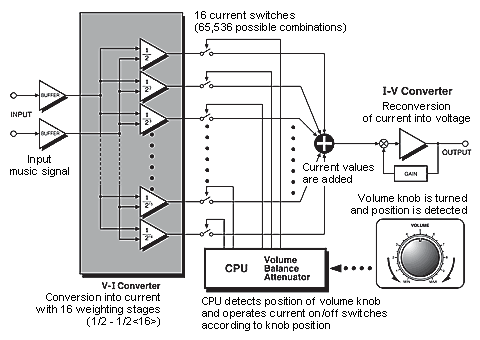AAVA is a totally new volume control concept that does away with the variable resistor and assures optimum performance and sound quality. Because the music signal does not have to pass through any variable resistors, there is no adverse influence from changes in impedance. This means that the outstanding S/N ratio and excellent THD of the amplifier is not compromised in any way, and the same superb sound quality will be obtained at any volume setting.
How AAVA works
How AAVA works AAVA operates by feeding the music signal to a V-I (voltage - current) converting amplifier where it is weighted in 16 steps [1/2, 1/4, ..., 1/32,768, 1/65,536]. The 16 current steps are turned on or off by 16 current switches, and the combination of switch settings determines the overall volume. The switching operation is controlled by a CPU according to the position of the volume control knob. The combined signal current forms a variable gain circuit that adjusts the volume. Finally, the combined current is converted back into a music signal voltage by an I-V (current - voltage) converter.

AAVA principle
Volume control resolution
AAVA adjusts the listening volume by means of 16 weighted V-I converter amplifiers which are controlled by 16 current switches. The number of possible volume steps set by the combination of these converter amplifiers is 2 to the power of 16 = 65,536.
AAVA maintains high S/N ratio and uniform frequency response
With conventional volume controls, the impedance increases significantly at settings that correspond to normal listening levels, thereby leading to increased noise. Because AAVA does not introduce any change in impedance, there is no deterioration of S/N ratio or alteration of frequency response. Changing the volume with AAVA does not mean introducing noise or otherwise degrading the sound quality of the amplifier.
No more left/right tracking differences or crosstalk
Because AAVA is an electronic circuit employing only fixed-value resistors, there is virtually no left/right tracking error also at low volume levels. Since channels can be kept separate, crosstalk also does not present a problem.
Simple circuit configuration
AAVA unifies the amplifier and volume control functions, resulting in a circuit that is electrically very simple. Long-term reliability is excellent, with performance and sound quality that will remain unchanged also after prolonged use.
AAVA means analog processing
The AAVA circuit converts the music signal from a voltage into a current, with the entire process being carried out in the analog domain.
Same operation feel as a conventional high-quality volume control
The volume control knob position is detected by a dedicated CPU which in turn selects the current switches for AAVA operation. Operating the knob therefore feels exactly the same as with a conventional control, and as before, operation via a remote commander is also possible.。
Attenuator and balance control also implemented by AAVA
The functions of the attenuator and the left/right balance control are covered by the AAVA circuit as well, eliminating the need for additional circuit stages. Keeping the configuration simple helps to maintain sonic purity.
 Accuphase Laboratory, Inc.
Accuphase Laboratory, Inc.
enrich life through technology

